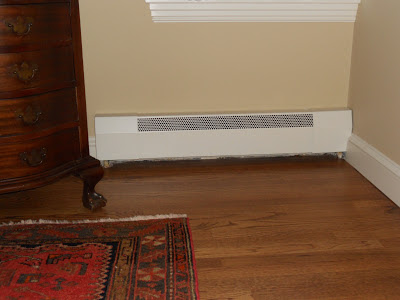Condensing
A condensing boiler is only slightly more efficient than a non-condensing boiler - unless the flue gas temperature has reached its dew point. The magic of flue gas condensation really starts to happen when the return water temperatures reach 130°F. It is at this point that the products of combustion, carbon dioxide and water vapor, turn to liquid condensate and release the energy that would otherwise have gone out the flue as waste. This latent heat is added to that already captured by the heat exchanger, resulting in an overall increase in efficiency. The lower the return temperature - the more latent heat that is recovered – the higher the efficiency.
Conventional baseboard was designed to operate at 180°F water supply temperature with a 20°F ΔT. So, a 10’ length of baseboard would provide approximately 5,500 to 6,000 Btu. However, with a supply temperature of 150°F (for a return temperature of 130°F), this same baseboard would provide just 3,800 Btu – a 40% reduction in delivered heat. One of two things must now occur – add more baseboards or increase the supply water temperature. The former is seldom done while the latter, being the most commonly implemented solution, results in a non-condensing boiler.
It is quite clear therefore that conventional baseboard is not a way to maximize efficiency when it comes to condensing boilers. So what are the alternatives?
- In-Floor Radiant: Operates most effectively with low water supply temps. May not be feasible in all applications.
- Flat Panel Radiators: Designed for high temperature but can work effectively with lower temperatures if sized accordingly. Also require significant system re-piping to accommodate monoflo tees. Account must also be taken of the amount of wall space required to accommodate the panels.
- Heating Edge HE2 High Capacity Hybrid Element: Designed to be installed in place of traditional baseboard. Provides significantly higher outputs at lower temperatures (see performance data here). Keep in mind that these ratings reflect average water temperatures with a 20° ΔT so an average temperature of 130°F should result in significant condensing of flue gas. By installing Heating Edge HE2 High Capacity Hybrid Element in place of the same footage of baseboard we can achieve the same BTHU outputs with Average Water Temperature of 140 degrees, which with a 20 degree delta T, will bring water back the boiler at 130 degrees ensuring that your condensing boiler is operating within the desired range and maximizing its potential.
Now that we have identified a practical and affordable way to deliver heat at lower temperatures, let’s consider other potential applications.
- Geothermal (GSHP): One of the challenges faced by geothermal installers is the relatively low supply water temperatures. Typically delivering temperatures of between 110°F and 120°F, hydronic applications are often hampered by the emitters. Traditional baseboard or in the case of commercial installations, convectors, would have to be tripled in size in order to satisfactorily heat the space. Radiant would require extensive and expensive integration. Heating Edge, with its higher capacity, could easily be installed in place of the existing baseboard with little or no additional labor costs.
- Solar Thermal: Ideally, solar thermal heating should be designed around a low temperature delivery system, typically in the 120 degree range. As with geothermal systems, the challenge is how to match the low temperature BTU output to the load. Heating Edge’s high output design makes it an ideal fit for this application.
Heating Edge is a high capacity, perimeter heating convector constructed of 20 gauge steel and aluminum designed for use in both residential and commercial applications. It is available in a variety of lengths from 2’ up to 8’.
ROI
Products such as condensing boilers, ground source heat pumps and solar thermal heating systems generally have higher upfront costs than their less efficient counterparts. While each technology has inherent features and benefits, each is also judged on its ability to provide a return on investment – whatever that might be. For this reason it is imperative that careful attention be paid to the application of the equipment and the distribution system being utilized by these technologies.
Payback calculations are based on performance criteria commensurate with the operating characteristics of the technology. These assumptions are generally based on “ideal” operating scenarios – a holistic approach that is often dependent on extraneous factors, not least of which is the distribution system.
Heating Edge can be characterized as an enabling resource inasmuch as it allows these technologies to perform to their optimum efficiencies and provide their respective returns on the initial investment. In other words, Heating Edge helps to make that ROI possible.
Learn more about Heating Edge here.


